As ACKMA members, we've all got something in common, and hopefully several things!! Primarily, we all have some link to caves and karst. You may be a cave guide, a land manager, a site interpreter, a ranger, a maintenance person, a speleologist, an educator, an administrator or a policy developer.
You may just support the aims and goals of the organisation (you may have some other important role that I've not thought of or included - but that's okay, keep reading!) You may be passionate about ensuring that caves and their associated karst systems are managed appropriately. We all know that the average 'Joe' really has little understanding of the words we primarily work with - 'karst' and 'speleology'. We also know that the typical concept of 'cave' can vary dramatically, and is highly dependent on an individual's knowledge and experiences.
At the 13th ACKMA conference in 1999 Tom Aley gave a presentation on karst hydrology. He stated that: "I am convinced that the two most common elements found in karst areas are calcium and stupidity. Calcium is more widely recognised than is stupidity ... With time we make some gains against karst stupidity, which we sometimes call ignorance to protect the guilty."
Clearly the primary way of altering such a situation is through education. A substantial section of the population has some consideration for protecting things like forests, or fauna - such as endangered native marsupials. Yet, how much of the general population considers the importance of subterranean areas, their groundwater or the associated ecosystems in a karst environment? I've heard it said that it's easy to protect something if it's got 'feathers, fur or friends'. So, what about the karst environment, caves and the specialised habitats and fauna that live underground? Have you thought about what role you can play in educating the community so that our goals of managing and protecting Australasia's karst environment? This article will outline a few examples of what's possible when people with passion and an interest in this area work together.
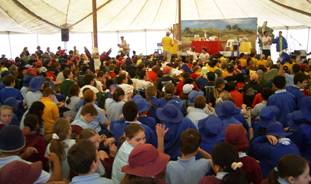 |
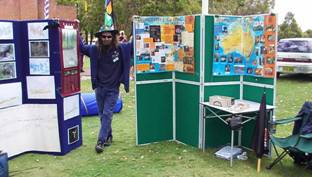 |
Several hundred children in the main tent learning |
ASF member Rob Susac at one side of the display. |
Another aspect that needs to be considered is raising the profile of speleology, and the appropriate management and protection of karst systems, with our colleagues in the broader environmental fields. Have you thought about membership with groups such as your local environmental group, the Wilderness Society, the Environmental Defender's Office, the Australian Association for Environment Education, the Conservation Council or Greening Australia? Many of these groups have state based groups or an equivalent group in each state. Networks and partnerships with all of these associations are important in raising the profile of the karst environment and those who work to manage and protect these areas. Attending meetings with these groups, sharing stories and situations, discussing roles, participating in events - collaborating on projects and issues - all of this can assist in raising the profile of the importance of the karst environment. Perhaps you could think of projects that you could work in partnership with other organisations. I challenge you to go out and join one of these organisations and get involved in the environment at another level.
THE ROLE THAT SPELEOLOGICAL GROUPS CAN PERFORM IN COMMUNITY ENVIRONMENTAL EDUCATION AND COMMUNITY DEVELOPMENT.
ACKMA members will be familar with the registered environmental organisation that focuses primarily on karst and speleology - the ASF (Australian Speleological Federation). The ASF has members throughout Australia - individuals and groups who are also passionate about many aspects of speleology. The members of the ASF are also involved in karst management in a number of ways. Some ASF members are community representatives on State Government advisory committees. The members of the ASF can also be involved in local cave management advisory committees.
Many speleological groups meet regularly, and have presentations and information about caves and karst in the local area. Such groups play an important role in community environmental education - firstly in training and educating new members in many aspects of speleology. ASF members also play an important role in introducing people to caves and the karst environment. A member of the public may have their first cave experience in your tourist cave or undertake an 'adventure tour' on the land that you manage. So what happens if that individual wishes to continue their learning of this activity and this special environment? Some people's desire to experience a cave may be brief and could be best met by a commercial operator or a tourist trip to a cave with infrastructure of lights. However, a percentage of individuals will really enjoy the experience that you, your staff or colleagues, has introduced them to. In these situations you could provide details of the ASF website - www.caves.org.au or a more local corporate member of the ASF - such as a speleological group.
However, speleological groups are also involved in the wider education of the community and to another extent - to government agencies. Many local speleological groups are involved in projects - projects to document caves and karst areas, to collect subterranean fauna for museums and universities, to rehabilitate caves that have been damaged, to track mark caves that receive regular visitation. There are a number of partnerships, where collaboration and consultation occur. Do you know what karst related projects are happening in your karst area or karst areas in your state? Speleologists are also involved in commenting on and writing submissions regarding land management plans or cave management plans. In this capacity, speleologists can assist in educating agencies regarding aspects of the karst environment. For example, in some cases, management plans are developed by head office staff who have skills in writing management plans or in developing policy but who may not have a good understanding of karst in general or of the specific area under their control. In these instances, it can be even more beneficial for speleological groups to be involved in submission writing or in having face-to-face consultation meetings on the issue being discussed.
Have you thought about being involved more with the karst in your area, or in your region or State? Do you know when the management plan is due and what information is contained in the management plan? Perhaps that's an area that interests you? If you are a manager or administrator - Have you thought more about contacting your local speleological groups/s and facilitating partnerships and collaboration on karst related issues? It'd be great if there was more networking and collaboration amongst those involved in this field of "natural resource management", which also includes aspects of ecotourism, recreation, tourism and interpretation.
This article started out with a discussion of the importance of community environmental education. As you may be aware, the co-ordination of public education events can take several forms. In Western Australia there have been a variety of events. A seminar series titled the 'ASF Speleo Seminars' began in 2002. There has also been speleological participation in regular annual local events such as community education displays. Displays at events such as community festivals and fairs can also play an important role in community education.
In Western Australia, it is the aim of the WA Speleological Groups to continue important community events and to hold regular "seminars" in the local community. I'm sure there's something happening in your area. Why don't you write something and send in some images of some other examples of community education, environmental education and community development.
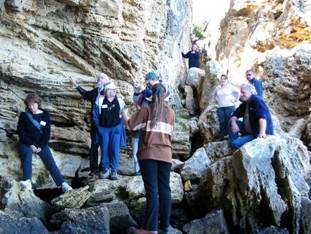 |
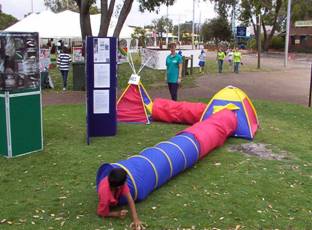 |
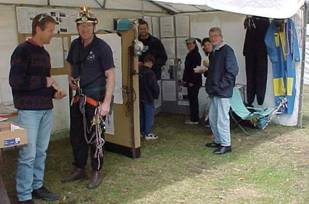 |
Jay Anderson talking to the group at the |
Jay Anderson looks over an interactive |
A group inside a display tent. Photo: Nicole Lincoln |
I've just been to the Limestone Coast Conference that was held in Naracoorte, South Australia. We saw sites where rubbish and waste were put into sinkholes or cenotes, facilitating pollution of groundwater and a karst system. Over time, this behaviour has been changing, but primarily through education. We heard about farmers, quarry operators and viticulturalists who are now making contact when they find a cave on their property. We saw how projects can involve partnerships to facilitate some positive change. Again, I'm reminded of the importance of collaboration and partnerships between a number of individuals and groups. For example the partnership between Green Corps and the Naracoorte National Park in removing a century of rubbish from Joanna Bat Cave. There's a lot of excellent projects and community environmental education that's happening around Australia, New Zealand and wider afield. It'd be great if members could find some time to share their stories, experiences and examples with the rest of us!!
SPECIFIC EXAMPLES FROM WESTERN AUSTRALIA
- Community Education Displays
The two WA Speleological Groups have worked together on several 'Community Education' Displays. Since 2002, these have primarily been held in the karst area north of Perth. For example the Yanchep National Park's 'Spring Fest', the Neerabup Community Environmental Festival and the 'Centenary' in March 2003 at Yanchep National Park. Since 2003, there has also been speleological involvement at the annual 'Children's Groundwater Festival'. This involved a karst display for teachers and primary school age children at Whiteman Park. This included a display, activities and an 'interactive' cave, which was quite popular with the children.
- Targeted Presentations and Seminars
The seminars are primarily aimed at outdoor leaders, cavers and environmentalists. The first of these seminars was in May 2002: 'Cavers caring for Caves'. The 2nd 'ASF Speleo Seminar' was in July 2003: 'Cave ecosystems, habitats and subterranean fauna'. This evening presentation also displayed the ACKMA posters (an excellent resource - there for members to utilise - ask Andy Spate!!). The 3rd 'ASF Speleo Seminar' was in September 2003: 'Subterranean Biodiversity and Threatened Fauna - specific examples from Western Australia'. This afternoon presentation was held to coincide with 'Biodiversity Month' and 'Threatened species day', in the Leeuwin Naturaliste National Park at Caveworks. Along with local speleologists, there were representatives from Greening Australia (WA), The Department of Conservation and Land Management and the Defence Services. A dinner was held after the event, which was attended by around 60 people.
- A partnership - The recent workshop between the ASF and Greening Australia (WA)
This is an example of a partnership between two environmental organisations with similar aims and objectives. The WA Conservation Committee saw the proposal as an initiative that would assist in our goals of public education about karst systems in WA. The proposal was discussed with a Greening Australia (WA) (referred to as GAWA) representative who decided to attend the 3rd ASF Speleo Seminar on 'Subterranean Biodiversity and Threatened Fauna' which was held in September 2003. The proposal was given support from the ASF executive and the January 2004 ASF Council Meeting. The GAWA representatives and ASF representatives met several times to discuss the proposal further and set some plans in motion. The workshop was then proposed for 11 September 2004 as part of A Sense of Place, Greening Australia (WA)'s Teacher Professional Development Program for 2004.
TOPIC - 'SUBTERRANEAN SAFARI - EXPLORING KARST SYSTEMS OF THE SWAN COASTAL PLAIN'
The theme was planned to be 'karst systems' and issues such as biodiversity, geology, hydrology, biology and management issues would also be discussed. The proposed workshop was planned to occur in the Perth, WA area. Local speleologists and environmental educators would be involved in preparing and presenting several sessions on karst systems. The day was planned to be interactive with several site visits.
Organisational objectives
GAWA and the ASF have a similar vision: The environmental and social objectives of both organisations were incorporated in this proposal. It was seen as an excellent opportunity for both groups to work together on raising the local communities understanding, knowledge and awareness of the karst system of the Swan Coastal Plain. As you may be aware, the karst system to the north of Perth is impacted by a number of factors and it is important that the community is educated about this important ecosystem that needs protecting and better management.
GAWA were 'very excited' and enthusiastic about this joint workshop proposal. They saw the proposal as an important initiative and were very pleased to support the proposed workshop. It is excellent that GAWA and the ASF partnered to undertake this important role of educating the local W.A. community about an important local issue and part of the Australian environment.
The Workshop
The day was co-facilitated by Lyndsay Tonner (GAWA Environmental Education Officer) and Jay Anderson (ASF). The group met early on a beautiful Saturday morning (after a week of rain) at the Point Walter Golf Course Conference Room. All of the participants received an information pack with handouts, readings and important information on the workshop. The first presentation was by Jay Anderson and set the scene for the day - introducing karst terminology and areas of importance in relation to karst systems on the Swan Coastal Plain. The second presentation was by Lex Bastian, who outlined the area's significance in terms of its geology.
The group then left the "classroom" and headed "on-site" for some "hands-on" karst interpretation. The group traveled by bus to several sites during an "action-packed" day!! During the day, ASF members, Lex Bastian and Rob Susac, assisted in numerous "on-site" discussions and answering of participant's questions.
Areas visited for the "on-site" field trips
- Blackwall Reach - Limestone cliffs along the river near Fremantle & Point Walter. Discussion of Karst features, Vegetation associations and Geomorphology.
- Kings Park - Karst features and hydrology. Some good examples of solution pipes & cross-section of epikarst in limestone. Short talk by Rob Susac on solution pipes and the site features. Participants also discussed hydrology and observed a spring.
- Carabooda area - Impact of development on Karst systems, subsidence & vegetation associations. An extra site visit to "One Tree Hill" to discuss the karst geology further.
- Yanchep National Park - reiterating the interconnectiveness, participating in an 'in-cave' trip and discussion on biodiversity. Examining and discussing, surface karst features, hydrology, subsurface karst features, speleogenesis & biospeleology. This included a second observation of a spring and a walk through Boomerang Gorge. The "in-cave" presentation was given by Eve Taylor (CALM staff member and local speleologist (ASF)) on biospeleology and hydrology. This visit was co-facilitated by Lex Bastian who pointed out aspects of geology and speleogenesis. The group then had a surface walk through "Boomerang Gorge" and discussed the surface karst features, area's hydrology and vegetation associations. The group then went to the Gloucester Lodge Museum to view a cross-section of the area's geology and a cave model. Other displays and interpretative forms were observed at the Museum. After the days debrief, the group completed evaluation forms and relaxed on the drive back to the city and the carpark!
The participants' comments and feedback indicated that they considered the day to be an enjoyable and excellent workshop. It was stated that: "The presentation of material by people with personal experience and commitment to the environment and caving" and the "expertise of presenters and their willingness to answer questions" was really important. Other comments included "Understanding the connectedness" and "Visiting actual sites and having very knowledgeable people imparting information". Given the success of this workshop, it is planned to offer this workshop in 2005 and beyond. Special thanks to those involved in this partnership are documented in the full article on this workshop (in the ASF publication Caves Australia)
FUTURE VISION
In Western Australia, the goal for the future would be to expand the "vision" to offer similar workshops to those individuals or groups who have land management and planning/development responsibilities. Additionally, it would be excellent to be able to expand the workshop to occur as a special workshop in other karst areas, for example: community workshops on karst and associated karst issues in a number of karst areas of Western Australia. Another vision involves obtaining funding to publish a brochure regarding basic karst concepts for local landowners and members of the public. On a more national scale, it would be my vision to see ACKMA members in partnerships with speleological and environmental groups - working in partnership in relation to karst issues around our countries. Let's make it happen!!